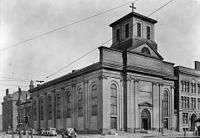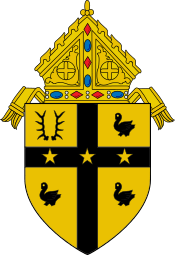Saints Peter and Paul Church (Detroit)
|
Saints Peter and Paul Church | |
|
Church in 2008 | |
| Location |
629 East Jefferson Avenue Detroit, Michigan |
|---|---|
| Coordinates | 42°19′55″N 83°2′18″W / 42.33194°N 83.03833°WCoordinates: 42°19′55″N 83°2′18″W / 42.33194°N 83.03833°W |
| Built | 1848 |
| Architect | Francis Letouneau, Peter Kindenkins |
| Architectural style | Romanesque Revival |
| NRHP Reference # | 71000431[1] |
| Significant dates | |
| Added to NRHP | September 03, 1971 |
| Designated MSHS | January 22, 1971[2] |
Saints Peter and Paul Church is a Roman Catholic church located at 629 East Jefferson Avenue in Detroit, Michigan. It is the oldest existing church in the city of Detroit,[2] and was listed on the National Register of Historic Places and designated a Michigan State Historic Site in 1971.[1][2]
History
In 1844, Bishop Peter Paul Lefevere, who served as coadjutor bishop of the Diocese of Detroit, began construction on Saints Peter and Paul Church; the cornerstone is dated June 29, 1844.[3] Francis Letourneau drew the plans, and Peter Kindenkens supervised the construction.[2] Construction was completed over four years, as the bishop paid for each stage of construction with cash.[4] The church was consecrated on June 29, 1848 and Bishop Lefevere used the church as his cathedral until his death in 1869.[4] The original parishioners were predominantly Irish, with some French families attending.[4]
Following Lefevere's death, Caspar Borgess, the second Bishop of Detroit, used the church as his cathedral[5] until 1877, when he gave the title to the building to the Jesuit Order with the intention of starting Detroit's first Catholic college.[3] The Jesuit college eventually became the University of Detroit-Mercy, and UDM's law school still occupies the building adjacent to the church.[3]
The church was altered in 1879 and 1882, completely renovated in 1892,[2] and remodeled again in 1911.[6] A chapel was added to the rear of the building in 1918.[6] Although these alterations changed the look of the church, the original plan has been substantially preserved.[2] The church is still in use, offering daily masses.[3]
Description
Saints Peter and Paul Church is a basilica-style church, made with walls of painted brick.[2] The front façade is gabled and topped by a short square cupola.[2] The cupola was originally intended to support a tall spire, which was never built.[4] There is a central entrance pavilion, set between arched windows and Ionic pilasters.[2] The pilasters continue along the side, separating the side elevation into seven bays with tall, rounded arch windows.[2] A heavy frieze conceals the sloping roof.[6]
The interior of the church features hand carved oak confessionals, a barrel vaulted ceiling painted with frescoes,[4] and an extraordinary Carrara marble altar designed by Gustave Adolph Mueller.[5] These details were added during later renovations; the organ case is the only surviving original element.[6]
Gallery
 Original planned elevation
Original planned elevation The church in 1934
The church in 1934 Side elevation of the church, 2007
Side elevation of the church, 2007
References
- 1 2 National Park Service (2008-04-15). "National Register Information System". National Register of Historic Places. National Park Service.
- 1 2 3 4 5 6 7 8 9 10 "Saints Peter and Paul Church". Michigan State Housing Development Authority. January 22, 1971. Archived from the original on 2013-10-16. Retrieved 2013-10-15.
- 1 2 3 4 "History". Saints Peter and Paul Jesuit Church. Retrieved 2013-10-15.
- 1 2 3 4 5 "Saints Peter and Paul Church" (PDF). City of Detroit Planning and Development Department. Retrieved 2013-10-15.
- 1 2 "Sts. Peter and Paul Catholic Church". Detroit1701.org. December 2012. Retrieved 2013-10-15.
- 1 2 3 4 Hill, Eric J.; Gallagher, John; American Institute of Architects Detroit Chapter (2002). AIA Detroit. Wayne State University Press. p. 30. ISBN 0-8143-3120-3.
| Wikimedia Commons has media related to Saints Peter and Paul Church (Detroit, Michigan). |



